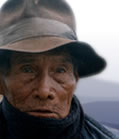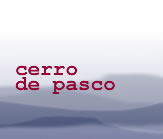THEMES IN THIS
TESTIMONY
Culture and Customs

Development

Education

Employment and Income

Environment

Health

History

Identity

Industry

Land

Livestock

Migration

Traditional Skills

Click on arrows
to find more
testimonies
featuring
these themes
|
|
Sex
|
male
|
|
|
Age
|
23
|
|
|
Occupation
|
student
|
|
|
Location
|
Tinyahuarco, Near Cerro de Pasco
|
|
|
Date
|
1995
|
|
summary
A concise and interesting interview. He is a young man with a university education who wants to remain in his local area and bring development to it. He talks about the effects of the mines on the area and also agrarian reforms. He gives his views on the way forward and how to keep the young people from leaving the area in search of work. His main point is that although the area supplies many raw materials, not just minerals but also wool and other produce, they are taken away and turned into products elsewhere. He believes that there should be metal foundries, garment factories etc in the local area and then they would benefit from being producers of raw materials. He also talks about his culture and the need to preserve it. There are lots of very good and interesting quotes.
detailed breakdown
|
You will need a password from Panos to view the full
transcript of the interview. To apply for a password, click here.
Once you have a password, click here to go to the beginning
of the transcript. You can also click on any section of the
breakdown of content below and go straight to the
corresponding part of the transcript.
|
| Section 1 |
Discussion of the name smelter- Tinyahuarco is known as the smelter community
|
| Section 1-2 |
Talks about family. His parents were campesinos from a herding background. Father started working in the mine. Grandfather also worked in the mines. Mining companies exchanged houses/land in area for houses in Lima in order to expand mine. Grandfather also worked for the Fernandinis - landlords.
|
| Section 3 |
Mentions different names for herders. Fernandinis were big land and livestock owners – they had many haciendas (estate farms).
|
| Section 4 |
Feels that mining, as much as ranching has contributed to the stagnation of the region in that they “have only served to create export centres, simply for extraction”. They have done nothing for the development of the area. The benefits are felt by people outside the region, those who receive and manufacture the raw materials
|
| Section 5 |
Agrarian reforms of the 60s - believes idea was good but the follow-up has not been successful. Discusses ways of making it better such as introducing technology to the countryside and the campesinos need better organisation. Developing industries at the mines that use the raw materials (eg making tools) would benefit the area and enable young people to find work locally, instead of leaving for Lima.
|
| Section 6-7 |
Feelings about the campesinos - believes they are not supported by the government and that children do not want to follow their parents as they see no future in the region. Feels university training is inadequate.
Quechua: the language is being lost. But he has learnt a lot from his parents’ way of life and about Andean culture. Mother has taught him Quechua and about healing plants. Father has taught him to shear sheep.
|
| Section 8 |
Migration
|
| Section 9 |
Influence of mining industry on the area: “it facilitates education work and improvements on housing, but that’s all. Its contribution is small and it’s diminishing.” Talks about influence of the US company, was present from 1900-73.
|
| Section 10 |
Influence of Cerro de Pasco Corporation on the area, in particular environmental impact. Birds have disappeared, lakes no longer there.
|
| Section 11-12 |
Thoughts on the privatisation of Centromin: just a change of ownership, unlikely to bring any benefits to the community. Centromin as bad as Cerro de Pasco. Thinks that the companies should pay mining taxes.
Wants to stay in the local area and help in its development. Feels that they must recognise their Andean culture. “I believe we’ll develop when we recognise our Andean culture; its not just to do with economic development but also with personal development, cultural development, and I think that these days, despite the fact that many of the young people don’t count on it, there are some who are producing interesting ideas to bring their villages forward….I hope that together we can help to improve the condition of life in our villages.”
|
|


